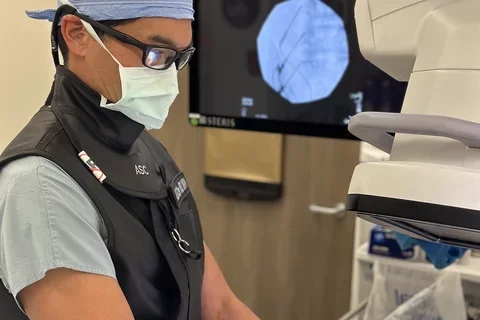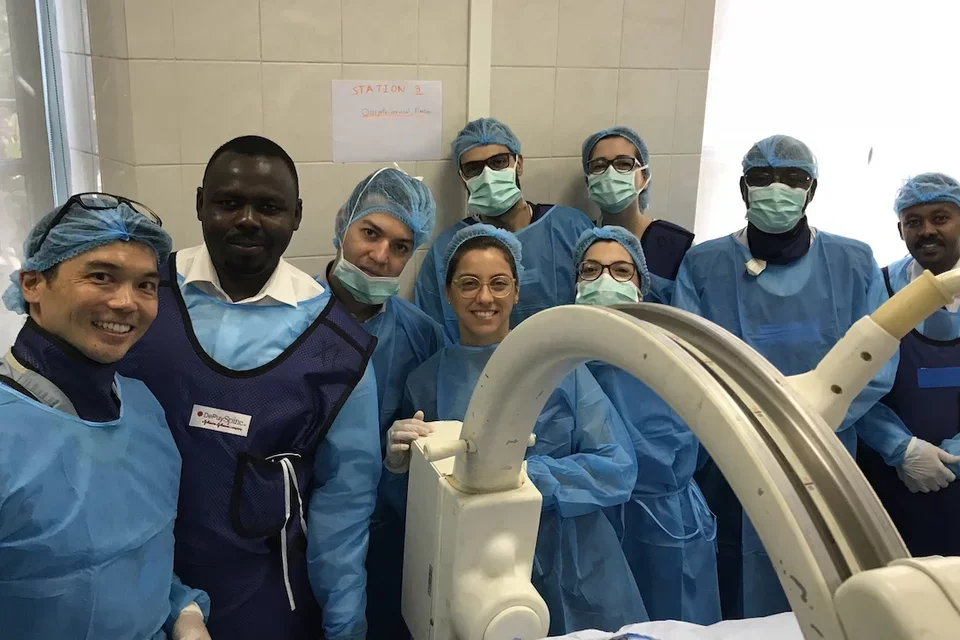What Is a Physiatrist?
Faculty Spotlight

A Day in the Life of Dr. Allen Chen, Physiatrist at UCLA Health
Physiatrists diagnose, treat, and rehabilitate people experiencing temporary or permanent physical impairment or pain that impacts their day-to-day functionality, their quality of life, and their ability to perceive themselves in a positive way.
“We provide patient-centered care and do our best to maximize our patients’ functionality, independence, and mobility,” says UCLA physiatrist Allen S. Chen, MD, MPH.
“It's a unique field because we address the function of the entire patient, as opposed to other fields that focus on a single organ or system.”
For Dr. Chen, a typical work week involves spending a few days in the clinic and a few days in the procedure suite, performing minimally invasive interventions and training medical students, residents, and fellows.
His favorite aspect of being a physiatrist is the variety of practice. While he spends plenty of time in the clinic seeing patients, he also gets to work with his hands doing minimally invasive procedures.
“I never do the same thing over and over again. Every week and every day, I do different things,” he says.
The variability of his practice and the broad spectrum of conditions he sees gives him the agility to quickly adapt to new technologies—such as new developments in spine care—and changing healthcare trends in general.
“Working in various areas gives me a unique perspective on how healthcare is changing.”
Being a physiatrist at an academic medical center conveys even more niche benefits. Dr. Chen enjoys teaching while also advancing his own professional development at conferences around the world and learning about advances in his field.
Thanks to physiatry’s overlap with sports medicine, he’s had the opportunity to provide medical coverage at international athletic events, including ultra marathons in Namibia and the Gobi Desert.
“There aren't many jobs that allow you to do so many different and incredible things,” he says.
“I’m very lucky to have had those opportunities, and I wouldn't have had them if it weren't for being a physiatrist.”

What Does a Physiatrist Do?
Physiatrists help patients affected by pain, injuries, or conditions regain physical functionality and lead their best lives. They develop multi-faceted treatment and rehabilitation plans catered to their patients’ individual needs and issues. For example, the plans they create for a patient with a long-term condition may look vastly different from a plan for a patient experiencing short-term physical impairment following an injury.
Physiatrists tend to focus on non-surgical interventions but may sometimes recommend minimally invasive procedures when necessary.
“We do a variety of procedures, including epidural injections, nerve blocks, spinal cord stimulator placements, and radiofrequency ablation (RFA).”
Beyond these core functions, a physiatrist’s work revolves around communicating and interacting with patients.
“Physiatry is very much a patient-facing field,” says Dr. Chen. “You have to be able to talk to people and get a broad sense of their physical functionality, lifestyle, and individual preferences and determine how interventions might affect them holistically—either positively or negatively.”
He uses the example of a surfer coming to the clinic with a debilitating injury to illustrate the importance of whole-human care and the difference it can make in someone’s life. While telling the patient to stop surfing might help them physically, it may not be the best option for their overall wellness—their lifestyle, happiness, and even mental health.
“If you tell a surfer they can't surf for the next two years, that's going to destroy them,” he explains.
In cases like this, physiatrists listen to their patients and exercise their compassion and empathy to find treatment compromises that physically rehabilitate the patient while minimizing the negative impact on their quality of life.
That’s why Dr. Chen says effective physiatrists are adaptable.
“Our field is broad and the things you do for patients are not going to be the same every time.”
A physiatrist might have two patients with magnetic resonance imaging (MRI) scans that look almost the same, but how the underlying condition impacts them and what the best course of treatment is for them will be vastly different. Their preferences for what kind of treatment they’re willing to endure will also vary highly. One patient may be comfortable undergoing surgery while another will hope to avoid it at all costs.
A physiatrist’s impact relies on hearing patient preferences and being adaptable enough to accommodate them to the best of their abilities. That’s because the cases physiatrists see tend to be far less black-and-white than cases seen in other fields—appendicitis, for example.
“Once the diagnosis of appendicitis is established, you know there’s only one course of treatment,” says Dr. Chen. “You do an appendectomy. You take out the appendix to save the patient’s life.”
When approaching a case of back pain, on the other hand, there are numerous options and treatment possibilities. That’s why patient communication is so central to this practice. Very few cases have only one obvious treatment course, so there’s room for flexibility and discussion before committing to a treatment plan.
Physiatrist Definition
A physiatrist is a physician specially trained in the field of physical medicine and rehabilitation (PM&R). They provide whole-patient care designed to help their patients regain physical functionality and overcome impairments due to chronic conditions, illnesses, or injuries.
Physiatrist vs Orthopedist - What’s the Difference?
Physiatrists and orthopedists (also known as orthopedic surgeons or orthopedic doctors) are both physicians who help patients manage pain and regain physical mobility and functionality.
Physiatrists and orthopedists complete different residency training following medical school:
- Physiatrists complete residency training in physical medicine and rehabilitation (PM&R).
- Orthopedists complete residency training in orthopedics and orthopedic surgery.
Generally speaking, they’re differentiated by the types of interventions they offer:
- Physiatrists focus primarily on non-surgical interventions.
- Orthopedists focus primarily on surgical interventions.
However, because different physiatrists do different things—and because orthopedics and physiatry overlap and crossover—the differences can become quite blurred.
Dr. Chen, for example, performs minimally invasive procedures in addition to offering non-surgical interventions
“I'm actually part of the Department of Orthopedic Surgery at UCLA,” Dr. Chen says. “My main appointment is through orthopedics, and my second appointment is through neurosurgery.”
The differences between a physiatrist and an orthopedist, he says, become more important in specific scenarios. Many sports injuries or spinal conditions, for example, are inoperable.
Patients with those conditions or who are not candidates for surgery may be better served by a physiatrist’s expertise in non-surgical interventions.

What Kind of Patients See a Physiatrist
The reasons patients seek a physiatrist’s care are as extensive and varied as the focus areas within the field. In general, many individuals see a physiatrist for help managing chronic pain or physical impairment.
Dr. Chen says that in many cases, patients see a physiatrist without realizing it or even expecting to.
“If someone is admitted to the hospital because of a heart attack, for example, a physiatrist might be among the many physicians they see and consult with.”
Furthermore, physiatrists may specialize in even more niche areas within the field.
“Some physiatrists handle post-operative care and see patients who’ve had joint replacements, organ transplants, or amputations,” says Dr. Chen.
Pediatric physiatrists see children with rehabilitation needs, such as those with cerebral palsy, while other physiatrists might work with mechanical engineers to create advanced prosthetics and assistive devices.
What Conditions Does a Physiatrist Treat?
Common conditions handled by physiatrists include, but are not limited to:
- Chronic pain and/or chronic conditions such as pinched nerves, arthritis, multiple sclerosis, and carpal tunnel syndrome
- Pain and functional challenges associated with developmental conditions such as cerebral palsy and neuromuscular disorders
- Recovery from a stroke, traumatic brain injury, or spinal cord injury
- Physical rehabilitation following an illness or surgical procedure
- Long-term musculoskeletal care for conditions such as osteoarthritis and osteoporosis
- Physical rehabilitation following any musculoskeletal sports injury
What Does a Physiatrist Do for Back Pain?
What a physiatrist might do for back pain will depend on the specific physiatrist’s area of expertise and the patient’s specific issue.
During intake, they’ll complete a comprehensive history and physical examination and may order tests, including imaging scans, such as x-rays or magnetic resonance imaging (MRI).
They’ll most likely recommend a non-surgical rehabilitation plan or minimally invasive treatment, such as:
- Physical Therapy
- Lifestyle modification
- Short course of medications
- Epidural injections
- Nerve blocks
- Spinal cord stimulator
- Radiofrequency ablation (RFA)

How to Become a Physiatrist
Aspiring physiatrists should expect to complete medical school and residency training in physical medicine and rehabilitation (PM&R). They may also complete additional fellowship training if they wish to practice a PM&R subspecialty, such as:
- Pain Medicine
- Sports Medicine
- Spinal Cord Injury Medicine
- Traumatic Brain Injury Medicine
- Hospice And Palliative Medicine
- Neuromuscular Medicine
- Pediatric Rehabilitation Medicine
Dr. Chen had no intention of becoming a physiatrist when he began medical school at New York University (NYU). He wasn’t even aware there was such a thing.
“I thought I wanted to go into orthopedic surgery. Then I thought I wanted to go into emergency medicine,” he explains. “Then I did some rotations at the NYU’s Rusk Rehabilitation center and learned about all these different fellowships you could do in sports and pain medicine,” he says.
Intrigued by sports medicine, he explored some of the options available under that umbrella. Following that path led him to discover PM&R.
Dr. Chen loves his work but admits it comes with unique challenges—like practicing any other medical specialty.
Physiatrists are trained to provide highly specialized care and sometimes zoom in on a patient’s specific problematic area. He must remind himself to keep the patient’s big-picture functionality top of mind when they come to him with highly localized issues, such as back pain.
“One of the most challenging things is understanding how localized conditions can affect a patient’s entire functional capacity,” he says. “It’s really important for me to keep that in mind.”
It can also be challenging, he says, to work in such a relatively unknown medical field.
“People often don't know what a physiatrist is or what they do,” he says, adding that he often calls himself a spine specialist, which is easier for people to understand.
Dr. Chen advises medical students interested in the field to rotate with multiple physiatrists who have different focus areas.
“That’s because my job is very different from that of a physiatrist who does stroke rehabilitation in a skilled nursing facility,” he explains. “Our work couldn't be more different, even though we’re part of the same field.”
Given the breadth of what the field covers, Dr. Chen says it’s critical for med students to understand its complexity.

How Long Does It Take to Become a Physiatrist?
It takes at least 12 years to become a physiatrist. These 12 years include:
- Earning an undergraduate degree at a college or university (4 years)
- Earning a medical degree by completing medical school (4 years)
- Completing residency training in physical medicine and rehabilitation (PM&R) (4 years)
Beyond this core training path, additional years may be required to complete fellowship training or to study for and pass board certification examinations.
Physiatrist Salary - How Much Does a Physiatrist Make?
According to recent Medscape compensation data, physiatrists practicing in the United States make an average of $322,000 annually.



